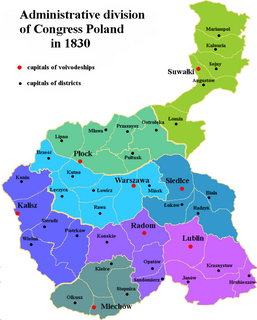 W
WFollowing three consecutive partitions of Poland carried out between 1772 and 1795, the sovereign state known as the Polish–Lithuanian Commonwealth disappeared from the map of Europe. In 1918 following the end of World War One, the territories of the former state re-emerged as the states of Poland and Lithuania among others. In the intervening period, the territory of the former Polish–Lithuanian Commonwealth was split between the Austrian Empire, the Kingdom of Prussia and the Russian Empire. These powers subdivided the territories that they gained and created new toponyms for the territories conquered. The subdivisions created were complicated by changes within those empires as well as by the periodic establishment of other forms of the quasi-Polish provinces led by a foreign head of state.
 W
WSubdivisions of the Polish–Lithuanian Commonwealth evolved over many centuries from the fragmentation of the Piast dynasty to the union of Poland and Lithuania.
 W
WBelastok Voblast or Belostok Oblast was a short-lived territorial unit in the Belarusian Soviet Socialist Republic (BSSR) during World War II from September 1939 until Operation Barbarossa of 22 June 1941 and again for a short period in 1944. The administrative center of the newly created voblast was the Polish: Białystok renamed Belastok.
 W
WThe Kingdom of Galicia and Lodomeria was subdivided into a number of counties for administrative purposes. In 1877 there were 73 administrative counties and in 1900 there were 78 counties. The administrative counties were responsible for storing vital records. The Kingdom of Galicia and Lodomeria was the largest and most populous crownland of Cisleithenia between 1772 and 1918. More widely, the central European region of Galicia is today split between the modern states of Poland and Ukraine. Despite having passed through several intermediate states during the great wars of the 20th century, the regions have mainly preserved their territorial integrity and continue to demarcate the jurisdiction of local government authorities in their successor states.
 W
WThe following is a list of cities of Poland which lost their city status.21st century 20th century: 1985– 1977 – 1975 – 1973 – 1972 – 1959 – 1957 – 1956 – 1954 – 1950 – 1948 – 1946 – 1945 – 1939 – 1934 – 1932 – 1928 – 1921 – 1919 – 1915 – 1914 19th century: 1897 – 1896 – 1895 – 1892 – 1888 – 1880 – 1876 – 1875 – 1874 – 1873 – 1870 – 1869 – 1852 – 1824 – 1820 – 1818 Before 19th century
 W
WCongress Poland was subdivided several times from its creation in 1815 until its dissolution in 1918. Congress Poland was divided into departments, a relic from the times of the French-dominated Duchy of Warsaw. In 1816 the administrative divisions were changed to forms that were more traditionally Polish: voivodeships, obwóds and powiats. Following the November Uprising, the subdivisions were again changed in 1837 to bring the subdivisions closer to the structure of the Russian Empire when guberniyas (governorates) were introduced. In this way, Congress Poland was gradually transformed into the "Vistulan Country". Over the next several decades, various smaller reforms were carried out, either changing the smaller administrative units or merging/splitting various guberniyas.
 W
WSubdivision of Polish territories during World War II can be divided into several phases, when territories of the Second Polish Republic were administered first by Nazi Germany and Soviet Union, then in their entirety by Nazi Germany and finally by the Soviet Union again. Starting with the reform of 1946, the administrative division was returned to Poland.
 W
WSubdivisions of the Duchy of Warsaw were based on departments that were headed by prefects. The subsidivions were based on the French model following the erection of the Duchy of Warsaw by Napoleon. The departments were in turn subdivided into traditional Polish powiats (counties). Initially six departments were created out of the province of South Prussia in the Kingdom of Prussia. After the 1809 Polish–Austrian War, and the Treaty of Schönbrunn, their number increased to ten. Each department was named after its capital city.
 W
WSubdivisions of the Kingdom of Poland evolved over several centuries as the fortunes of the several entities known as the Kingdom of Poland ebbed and flowed.
 W
WSubdivisions of the Second Polish Republic became an issue immediately after the creation of the Second Polish Republic in 1918. The Polish-Lithuanian Commonwealth had been partitioned in the late 18th century. Various parts of new Polish territory had belonged to different administrative structures of Austrian Empire, Imperial Germany and Russian Empire.